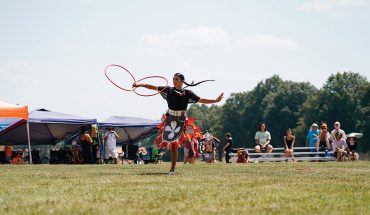by Ernest Dollar, director, City of Raleigh Museum
photographs by Tierney Farrell
On display in the City of Raleigh Museum is a piece of paper that holds the key to a 160-year-old mystery. Scrawled in black ink in elegant Victorian handwriting is a list of the property of onetime Raleigh resident Dr. James O. Watson, who died in his home here in 1852.
When the executors of his estate divided his material goods, such as hoes, mules, and spinning wheels, they also had to figure out what to do with the 50 people he held as slaves, listed only by their first names: Kitty, Clarry, Lewis, Judy, Cage, Robbin, Amanda, Gastin, Harry, Jim, and 40 others.
With the death of their master, these people faced one of the most abominable cruelties of slavery – their families were torn apart, divided like furniture among heirs. It meant that they lost their personal histories as well. One of the lesser-known evils of slavery is this: the massive, widespread theft of identity.
This single sheet of paper was rediscovered during an inventory of the museum’s collection in 2012. Now, a century and a half later, researchers are using it – and cutting-edge science – to discover the final fate of these 50 black men, women, and children.
Any time a fact, image, or name can be associated with an enslaved person, it’s a big deal. The identities of a great many Americans held as slaves are unknown. Over 250 years, an estimated 500,000 Africans were shipped to mainland America. That population grew to four million on the eve of the Civil War. Names like those listed in Watson’s document give researchers an invaluable starting point to reconstruct the identities of generations, reconstruct individual lives, and, more broadly, give hope to a growing number of African Americans searching for their lost roots.
Johnston County’s Vandora Blount is one. “I was never interested in history,” Blount says, but over the past 50 years, since she first helped her mother and cousin sift through boxes of old documents in the North Carolina State Archives, the search for her family’s story has grown into a passion.
Looking over the Watson inventory in the museum recently, Blount grew increasingly excited to recognize a few names. Common names, perhaps, but the hope that one of them could be her long-lost ancestor was thrilling.
Blount’s research into her own family has revealed that names were often repeated over many generations. Historians speculate this common practice was designed to keep the memory of ancestors alive. It was all they could do with only a first name to go by – because it wasn’t until the end of the war and emancipation that enslaved people received freedom, opportunity – and a last name. This is what makes the 1870 census, the first after the war, so incredibly valuable. But tracing family connections further back into slavery is difficult, a point that many African American researchers refer to as “hitting the wall.”
Blount has worked hard to break through this historic obstacle, and has made some enlightening discoveries. Using every record she could find – tax records, land deeds, and court documents – she has found a few family members living in Sampson County before the Civil War.
Digging deep
At the City of Raleigh Museum, we knew our own research into the lives of the 50 enslaved people named on Dr. Josiah O. Watson’s property list would first rely on some understanding of Dr. Watson himself.
A short search revealed him to be a member of one of North Carolina’s most illustrious families. A doctor in the War of 1812, he became a life-long friend of future president Andrew Jackson. He also served as a justice of the peace and represented Johnston County in North Carolina’s House of Commons in 1828.
By 1850, Watson had amassed exceptional wealth. He owned several plantations in Johnston County, one that housed 170 enslaved people alone. He had 12 more people working as slaves at his Raleigh home, which he called Sherron.
Watson’s heir, Orren Dodd, took possession of his “property” in 1853, but things were unsettled with Watson’s son, John W. B. Watson. Watson sued Dodd and the case reached North Carolina’s Supreme Court. Dodd won the case, left the state, and headed to Arkansas with slaves in tow. This is where the path gets harder to follow.
Census takers in 1860 found Dodd living in Rapps Barrens, Ark., with 35 slaves, raising the question: What happened to the other 15 people? Were they sold to pay for the journey? Did they stay in Raleigh? Did they perish on the long move west?
Comparing their names on Watson’s estate list to the first census after the Civil War provides tantalizing evidence of their final fates.
One enslaved person in Watson’s estate named Henderson, for instance, could be the same Henderson Watson listed on the 1870 census living in Smithfield. Cage, another man on the list, could be the same Cage Bryant who appears in LaGrange, Ark., and noted his birthplace as North Carolina. The coincidence of names suggests some of these people stayed with family and friends in North Carolina, while others started new lives out west.
These and many other questions – just like Vandora Blount’s – remain unanswered. Watson’s list is currently on display in the COR museum in hopes that a visitor may recognize a name and make a connection. Only with time and research from families in North Carolina and Arkansas can the final mysterious fate of these 50 people finally be solved. And only with the perseverance and tenacity of individuals like Blount will other family histories be made whole.
The advancement of science also provides an intriguing new tool to link descendant and ancestors. Besides the Internet’s ability to share previously undiscovered archival material, genetic testing of DNA has given researchers a powerful tool to link families in present to those of the past. Armed with these tools, the task of restoring the dignity to those men and women who had it stolen in slavery begins.
For the living, who are seeking to solve a painful mystery in their own pasts, the search begins with these 50 names.





